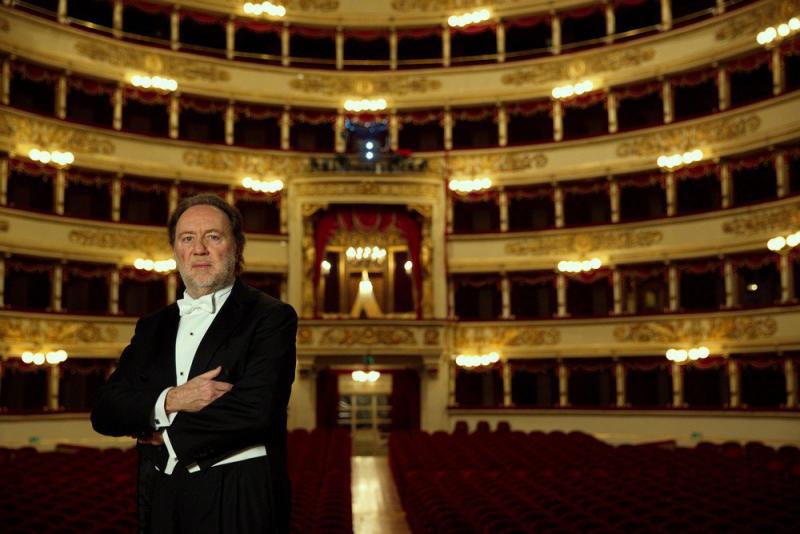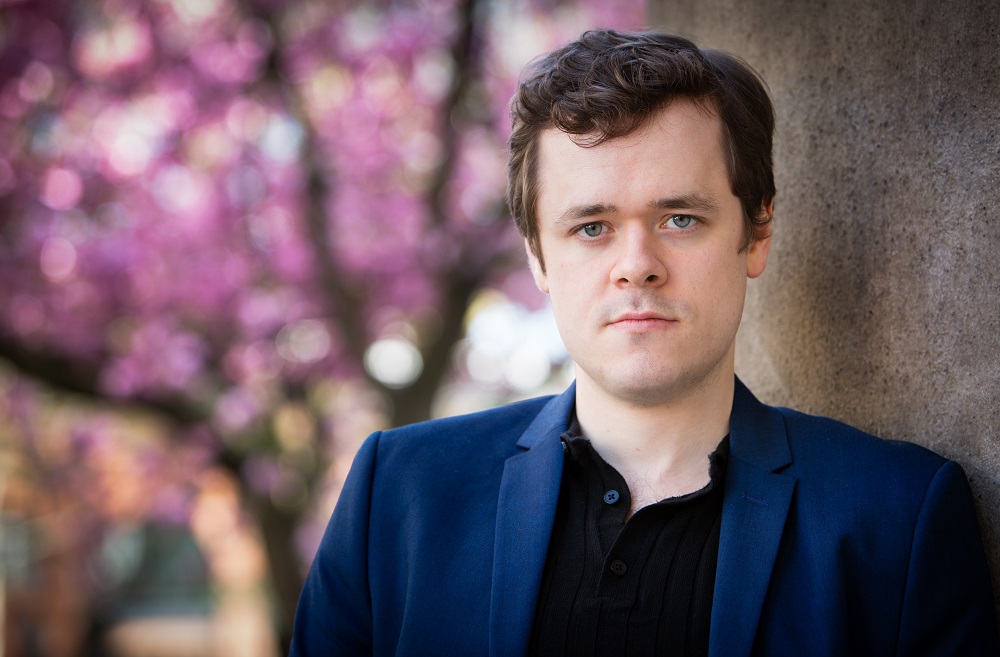Grosvenor, Filarmonica della Scala, Chailly, Barbican review - Tchaikovsky’s force of destiny shines bright | reviews, news & interviews
Grosvenor, Filarmonica della Scala, Chailly, Barbican review - Tchaikovsky’s force of destiny shines bright
Grosvenor, Filarmonica della Scala, Chailly, Barbican review - Tchaikovsky’s force of destiny shines bright
Dramatic flair and sonic luxury from the Italians in a night to remember

You could probably guess from the assembling audience that the orchestra making its Barbican debut last night came from Milan. That many mink coats rarely congregate in a London concert hall.
La Scala’s seemingly unrufflable players, under Chailly’s economical yet masterful direction, were on home territory for the Rossini Overture to La gazza ladra (The Thieving Magpie). This playing set a pattern for the evening: measured tempi, attention to detail, spacious phrasing that breathed as a star singer might, a rich, dark tone as velvety as Chailly’s crimson podium, and an ability to pace crescendos that later paid remarkable dividends in the Tchaikovsky Symphony No. 4. Today fast tempi are often considered historically informed and orchestras can sound as if they're eyeing the next train out. But Chailly’s viewpoint was altogether different: allowing the music room to breathe gave the ear and mind time to take in the significance of each harmony, along with the nuance, balance and structure that ultimately build meaning.
Benjamin Grosvenor (pictured below by Patrick Allen/Opera Omnia), the British former prodigy turned national treasure, was soloist for the Grieg Piano Concerto. Now in his mid-twenties, he still looks about 12, but his playing has gained in heft and his assured virtuosity seemed much at home in the fire, ice and thunder of this ever-popular work. He is the least showy of performers, but plays with an assurance in which his manual choreography is a joy to witness. And he matched the orchestra’s suave power with sizeable tone that never lost its sheen of beauty: silken passagework, modest and sincere songfulness and a magnificently paced cadenza, to which Chailly and the orchestra responded as if with hushed awe. There was perhaps a downside to Chailly’s leisurely approach: with lavish rubato, the first movement occasionally slowed to a sleepy pace, and at times during the finale Grosvenor seemed to be trying to propel the music forward with more overt energy than the orchestra, which once or twice responded with what sounded like a completely different tempo. But thoughts of this were wiped out by Grosvenor’s encore, Grieg's rather pure-sounding Poème érotique, played with disarming tenderness.
There was perhaps a downside to Chailly’s leisurely approach: with lavish rubato, the first movement occasionally slowed to a sleepy pace, and at times during the finale Grosvenor seemed to be trying to propel the music forward with more overt energy than the orchestra, which once or twice responded with what sounded like a completely different tempo. But thoughts of this were wiped out by Grosvenor’s encore, Grieg's rather pure-sounding Poème érotique, played with disarming tenderness.
So to Tchaikovsky’s Fourth. Oh no, not again? Well, that crunching noise you can hear is the sound of a critic eating her words. Hear an interpretation like this one and you see why this work is played so often: it’s fabulous. In Chailly’s hands the first movement emerged as an overwhelming emotional statement, marvellously paced and structured, heart and logic fusing to spectacular effect. With musical drama like this, who needs opera?
The choral brass opening was a glory, the strings would give a great chorus a run for its money, and the woodwind were exceptional: if the oboist ever needed oxygen in the opening of the second movement, there was precious little sign of it – he’s either a master of circular breathing or has lungs the size of La Scala itself. The pizzicato third movement worked balletic magic, and the crash-bang-wallop fourth does what it usually does, only a lot better than usual, all of it aided by the loving attention to detail that characterised the whole concert. Try the phrasing of the cellos’ counter-melody in the first movement’s second theme, lifting on a diminuendo like a tenor reaching for a falsetto top register; or the subtle lean at the top of a falling chromatic run in the woodwind; or the smoothness of the sure-fire exchange between sections at the end of the third movement.
And here’s a chewy question about cause and effect. Listening to an Italian opera orchestra playing a Russian symphony, do we hear Verdian influences in the music because we expect to, or because of the orchestra’s style of playing? The work opens with a powerful fanfare, designed as a "Fate" motif; there follow two main themes, the first brooding, chromatically yearning, the second plaintive and lilting. The patterns of each bear a certain resemblance to Verdi’s Overture to La forza del destino, and the agony of fate is what this symphony is all about. It's worth some thought.
An encore from Verdi himself – the Overture to I vespri siciliani – sent us home hoping for a return visit from the Milanese as soon as possible.
rating
Share this article
The future of Arts Journalism
You can stop theartsdesk.com closing!
We urgently need financing to survive. Our fundraising drive has thus far raised £49,000 but we need to reach £100,000 or we will be forced to close. Please contribute here: https://gofund.me/c3f6033d
And if you can forward this information to anyone who might assist, we’d be grateful.

Subscribe to theartsdesk.com
Thank you for continuing to read our work on theartsdesk.com. For unlimited access to every article in its entirety, including our archive of more than 15,000 pieces, we're asking for £5 per month or £40 per year. We feel it's a very good deal, and hope you do too.
To take a subscription now simply click here.
And if you're looking for that extra gift for a friend or family member, why not treat them to a theartsdesk.com gift subscription?
more Classical music
 Kilsby, Parkes, Sinfonia of London, Wilson, Barbican review - string things zing and sing in expert hands
British masterpieces for strings plus other-worldly tenor and horn - and a muscular rarity
Kilsby, Parkes, Sinfonia of London, Wilson, Barbican review - string things zing and sing in expert hands
British masterpieces for strings plus other-worldly tenor and horn - and a muscular rarity
 From Historical to Hip-Hop, Classically Black Music Festival, Kings Place review - a cluster of impressive stars for the future
From quasi-Mozartian elegance to the gritty humour of a kitchen inspection
From Historical to Hip-Hop, Classically Black Music Festival, Kings Place review - a cluster of impressive stars for the future
From quasi-Mozartian elegance to the gritty humour of a kitchen inspection
 Shibe, LSO, Adès, Barbican review - gaudy and glorious new music alongside serene Sibelius
Adès’s passion makes persuasive case for the music he loves, both new and old
Shibe, LSO, Adès, Barbican review - gaudy and glorious new music alongside serene Sibelius
Adès’s passion makes persuasive case for the music he loves, both new and old
 Anja Mittermüller, Richard Fu, Wigmore Hall review - a glorious hall debut
The Austrian mezzo shines - at the age of 22
Anja Mittermüller, Richard Fu, Wigmore Hall review - a glorious hall debut
The Austrian mezzo shines - at the age of 22
 First Person: clarinettist Oliver Pashley on the new horizons of The Hermes Experiment's latest album
Compositions by members of this unusual quartet feature for the first time
First Person: clarinettist Oliver Pashley on the new horizons of The Hermes Experiment's latest album
Compositions by members of this unusual quartet feature for the first time
 Gesualdo Passione, Les Arts Florissants, Amala Dior Company, Barbican review - inspired collaboration excavates the music's humanity
At times it was like watching an anarchic religious procession
Gesualdo Passione, Les Arts Florissants, Amala Dior Company, Barbican review - inspired collaboration excavates the music's humanity
At times it was like watching an anarchic religious procession
 Classical CDs: Camels, concrete and cabaret
An influential American composer's 90th birthday box, plus British piano concertos and a father-and-son duo
Classical CDs: Camels, concrete and cabaret
An influential American composer's 90th birthday box, plus British piano concertos and a father-and-son duo
 Cockerham, Manchester Camerata, Sheen, Martin Harris Centre, Manchester review - re-enacting the dawn of modernism
Two UK premieres added to three miniatures from a seminal event of January 1914
Cockerham, Manchester Camerata, Sheen, Martin Harris Centre, Manchester review - re-enacting the dawn of modernism
Two UK premieres added to three miniatures from a seminal event of January 1914
 Kempf, Brno Philharmonic, Davies, Bridgewater Hall, Manchester review - European tradition meets American jazz
Bouncing Czechs enjoy their Gershwin and Brubeck alongside Janáček and Dvořák
Kempf, Brno Philharmonic, Davies, Bridgewater Hall, Manchester review - European tradition meets American jazz
Bouncing Czechs enjoy their Gershwin and Brubeck alongside Janáček and Dvořák
 Solomon, OAE, Butt, QEH review - daft Biblical whitewashing with great choruses
Even a top soprano and mezzo can’t make this Handel paean wholly convincing
Solomon, OAE, Butt, QEH review - daft Biblical whitewashing with great choruses
Even a top soprano and mezzo can’t make this Handel paean wholly convincing
 Two-Piano Gala, Kings Place review - shining constellations
London Piano Festival curators and illustrious friends entertain and enlighten
Two-Piano Gala, Kings Place review - shining constellations
London Piano Festival curators and illustrious friends entertain and enlighten
 Echo Vocal Ensemble, Latto, Union Chapel review - eclectic choral programme garlanded with dance
Beautiful singing at the heart of an imaginative and stylistically varied concert
Echo Vocal Ensemble, Latto, Union Chapel review - eclectic choral programme garlanded with dance
Beautiful singing at the heart of an imaginative and stylistically varied concert

Add comment